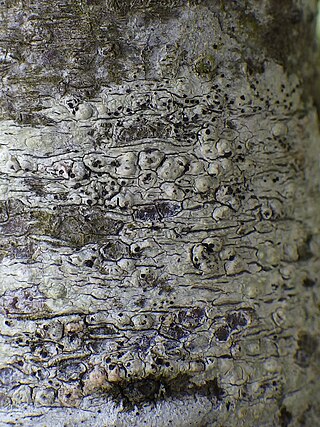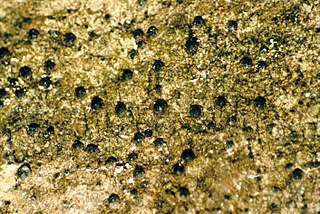
The Arthoniales is the second largest order of mainly crustose lichens, but fruticose lichens are present as well. The order contains around 1500 species, while the largest order with lichenized fungi, the Lecanorales, contains more than 14000 species.

The Lecanoraceae are a family of lichenized fungi in the order Lecanorales. Species of this family have a widespread distribution.

The Baeomycetales are an order of mostly lichen-forming fungi in the subclass Ostropomycetidae, in the class Lecanoromycetes. It contains 8 families, 33 genera and about 170 species. As a result of molecular phylogenetics research published in the late 2010s, several orders were folded into the Baeomycetales, resulting in a substantial increase in the number of taxa.
Josefpoeltia is a genus of lichen-forming fungi in the family Teloschistaceae. It has three species. The genus was circumscribed in 1997 by lichenologists Sergey Kondratyuk and Ingvar Kärnefelt, with J. boliviensis assigned as the type species. The genus name honours lichenologist Josef Poelt, (1924-1995) who was a German-Austrian botanist and was Professor of Systematic Botany at the Free University of Berlin in 1965.
Huea is a genus of lichenized fungi in the family Lecanoraceae. It was circumscribed by Carroll William Dodge and Gladys Elizabeth Baker in 1938.
Ingaderia is a genus of lichen-forming fungi in the family Opegraphaceae. The genus was circumscribed by British botanist Otto Vernon Darbishire in 1897.
Zwackhiomyces is a genus of lichenicolous fungi in the family Xanthopyreniaceae. The genus was circumscribed by Martin Grube and Josef Hafellner in 1990, with Zwackhiomyces coepulonus assigned as the type species.
Bryonora is a genus of crustose lichens in the family Lecanoraceae. The genus was circumscribed in 1983 by lichenologist Josef Poelt, with Bryonora castanea assigned as the type species.
Clauzadeana is a genus of lichen-forming fungi in the family Lecanoraceae. The genus was circumscribed in 1984 by Claude Roux, with the crustose species C. instratula assigned as the type.

Lecidella is a genus of crustose lichens in the family Lecanoraceae.

Pyrrhospora is a genus of lichen-forming fungi in the family Lecanoraceae. The genus was circumscribed by German lichenologist Gustav Wilhelm Körber in 1855, with Pyrrhospora quernea assigned as the type species.

Candelariaceae is a family of lichen-forming fungi in the order Candelariales. It contains seven genera and about 73 species.

Skyttea is a genus of lichenicolous (lichen-dwelling) fungi in the family Cordieritidaceae. The genus was circumscribed in 1981 by lichenologists Martha Allen Sherwood, David L. Hawksworth, and Brian J. Coppins, with Skyttea nitschkei assigned as the type species.
Poeltiaria is a genus of lichen-forming fungi in the family Lecideaceae. It was circumscribed in 1984 by lichenologist Hannes Hertel, with Poeltiaria turgescens assigned as the type species.
Josef Hafellner is an Austrian mycologist and lichenologist. He was awarded the Acharius Medal in 2016 for his lifetime contributions to lichenology. Before his retirement, he was a professor at the Karl-Franzens-Universität in Graz. Hafellner started developing an interest in lichens while he was a student at this institution, studying under Josef Poelt. He earned a master's degree in 1975 and a PhD in 1978, defending a doctoral thesis about the genus Karschia. In 2003, Hafellner received his habilitation. By this time, he had studied with French lichenologist André Bellemère (1927–2014) at Saint-Cloud, where he learned techniques of transmission electron microscopy and how their application in studying asci could be used in lichen systematics. His 1984 work Studien in Richtung einer natürlicheren Gliederung der Sammelfamilien Lecanoraceae und Lecideaceae has been described as "probably the single most influential publication in lichen systematics in the latter half of the 20th century".
Vezdaea is a genus of crustose lichens in the monotypic family Vezdaeaceae, which itself is the only taxon in the order Vezdaeales. The genus was circumscribed by Elisabeth Tschermak-Woess and Josef Poelt in 1976. The genus name honours Czech lichenologist Antonín Vězda (1920-2008).

Scoliciosporum is a genus of lichens in the family Scoliciosporaceae.

Calogaya is a genus of lichen-forming fungi belonging to the family Teloschistaceae. It has 19 species. The genus was circumscribed in 2013 by Ulf Arup, Ulrik Søchting, and Patrik Frödén. The generic name Calogaya honours Dr. Ester Gaya, a Spanish botanist from the University of Barcelona.
Bryostigma is a genus of lichen-forming fungi of uncertain familial placement in the order Arthoniales. The genus was circumscribed in 1979 by Josef Poelt and Peter Döbbeler, with the muscicolous lichen Bryostigma leucodontis assigned as the type species. A dozen Arthonia species were transferred into the genus in 2020 following molecular phylogenetic analysis of the family Arthoniaceae that showed distinct phylogenetic lineages that were basal to that family. The genus contains several parasitic species that occur on hosts having chlorococcoid photobionts.
Josef Poelt was a botanist, bryologist and lichenologist. He held the chair in Systematic Botany and Plant Geography at the Free University of Berlin and then was head of the Botanical Institute and Botanical Garden of Graz University, Austria.








